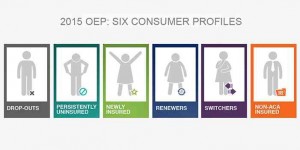 While shopping is a life sport, and even therapeutic for some, there’s one product that’s not universally attracting shoppers: health insurance.
While shopping is a life sport, and even therapeutic for some, there’s one product that’s not universally attracting shoppers: health insurance.
McKinsey’s Center for U.S. Health System Reform studied people who were qualified to go health insurance shopping for plans in 2015, covered by the Affordable Care Act.
McKinsey’s consumer research identified six segments of health insurance plan shoppers — and non-shoppers — including 4 cohorts of insured and 2 of uninsured people. The insureds include:
- Newly-insured people, who didn’t enroll in health plans in 2014 but did so in 2015
- Renewers, who purchased health insurance in both 2014 and 2015
- Switchers, insured people who bought one plan in 2014 but made a change to a different plan in 2015; and,
- Non-ACA insureds, who enrolled in a non-ACA plan (the large majority of these people were grandfathered into an existing plan).
Among the non-insured, the two segments are:
- Drop-outs, those who enrolled in health insurance in 2014 but who did not re-enroll in 2015; and,
- Persistently uninsured people, who didn’t purchase insurance in either 2014 or 2015.
As consumer segments, people in each cohort share certain demographic characteristics. The Renewers, the largest single group of ACA-insured people comprising 41% of the 2015 ACA market, tend to be female, satisfied with their 2014 plans, and older people with medium to high health risks. The Newly Insureds (about 12% of the 2015 ACA insureds) also tend to be female, but this group is keen to access preventive services and stay healthy. Most newly-insured people also got advice from friends or family when shopping for health insurance, an indication that social networks are an important force for educating and supporting people in making healthcare choices. The Switchers (34% of the ACA insurance market that moved from one ACA plan to a new one in 2015) were less satisfied with their 2014 health plans — especially sensitive to monthly premium prices and out-of-pocket costs. All three of these insured groups value health insurance the way they do insurance coverage and financial planning.
Then there are those who do not value health insurance quite so highly. The Persistently Uninsured group splits roughly in half, into those people who chose not to shop for insurance (47%) and those who did shop, but did not ever buy into a plan (53%). Among those who didn’t shop, choosing to be uninsured in both 2014 and 2015, 3 in 4 said they could not afford the premiums charged by plans in the ACA insurance marketplace. Note, though, that 9 in 1o of Persistently Uninsured people also were unaware of the subsidy amounts (premium discounts) for which they’d qualify. Persistently Uninsured people tend to be male and younger, 30-49, perceiving low health risks. Both those who shopped and didn’t shop say it’s mostly about the premium costs of options available on the marketplaces.
For this study, McKinsey polled about 3,000 ACA-qualified health plan consumers and individually insured consumers (that is, people who were not eligible for employer-sponsored, Medicaid or Medicare health plans).
Health Populi’s Hot Points: The McKinsey research shows that not all consumers are purchasing insurance based solely on (the cheapest) cost. The Switchers are the group to learn from, moving from one plan in 2014 to another one in 2015. In that segment of shoppers, there’s a nuance beyond pure cost: it has to do with one’s experience with their 2014 health plan. This could be related to a customer service issue or to constraints felt when seeking a health provider in an (unexpected) narrower network of providers. Thus, value — cost + positive experience (as defined by the individual) — is playing a role for some health insurance shoppers who are flexing new muscles as health consumers.
Of course “value” cuts both ways, and for those people who continue to opt-out of purchasing insurance, there’s a “devaluation” of risk, a concept which I discussed with the McKinsey team. The Persistently Uninsured and Dropouts don’t value health insurance in their lives, at least as part of a personal risk-management scenario. They are making this choice, a great many not even knowing what premium discount they might receive to lower the price of buying a plan.
Note that this kind of information gap isn’t confined to just the uninsured-by-choice. Even people with health insurance have substantial gaps regarding how to use their plan, and how much services cost when using their plan. A survey conducted for SCIO Health Analytics by the Harris Poll in October 2014 found that 2 in 5 insured adults don’t have a good understanding of what’s covered in their health plan, and one in five of these insured people did not visit a doctor for a health concern in the past year due to cost. Remember: these health service-avoiders have health insurance.
SCIO’s CEO concluded that their survey “reveals a significant knowledge gap in the specifics of (consumers’) health care options that may eventually lead to unnecessary risks and costs.”
Thus, health insurance literacy remains a huge challenge for Every Kind of People – those who shop for new health insurance plans, those who don’t shop and don’t know their premium discount opportunity, and even those with health insurance who self-ration care in the present due to cost — devaluing their future risk of getting sicker.




 Thank you FeedSpot for
Thank you FeedSpot for